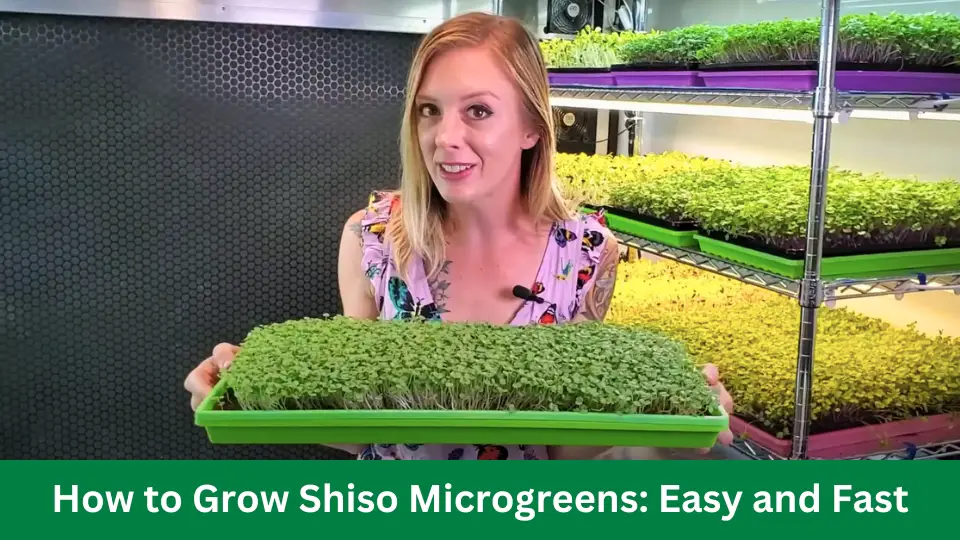To grow shiso microgreens, sow the seeds on moist soil, cover them with a thin layer of soil, and water regularly. Microgreens are a nutritious addition to your meals and can be grown easily at home without much effort.
Rich in vitamins and antioxidants, shiso microgreens add freshness and flavor to salads, sandwiches, and other dishes. Shiso microgreens are becoming increasingly popular among home gardeners and chefs with their vibrant green leaves and distinct taste.
Following a few simple steps, you can enjoy these delicious and nutritious greens in a few weeks. So, let’s get started and learn how to grow shiso microgreens!
Getting Started The Shiso Microgreens Growing
Growing shiso microgreens is a rewarding and straightforward process that can be done right in your own home. In this section, we will guide you through the initial steps you need to take to ensure a successful shiso microgreens growing experience. Let’s dive in!
Choosing The Right Shiso Variety
Before you begin growing Shiso microgreens, choosing the right shiso variety for your needs is essential. There are several different types of shiso, including green shiso (also known as perilla) and red shiso.
Each variety has its unique flavor and appearance, so consider your preferences when selecting. Green shiso has a mild, herby taste, while red shiso has a stronger, spicy flavor.
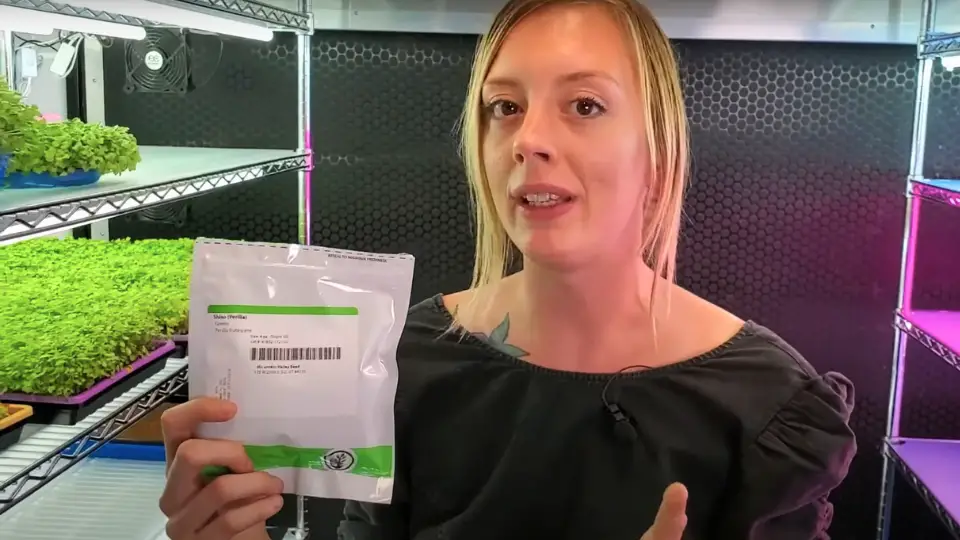
Equipment And Supplies Needed
Once you’ve chosen the shiso variety you want to grow, it’s time to gather the necessary equipment and supplies. Here’s a list of what you’ll need:
| Equipment | Supplies |
|---|---|
| Seed tray or shallow container | Shiso seeds |
| Growing medium (such as coco coir or potting soil) | Spray bottle |
| Grow lights or a sunny spot near a window | Water |
| Plastic wrap or humidity dome | Optional: a small fan for ventilation |
Preparing The Growing Medium
Now that your equipment and supplies are ready, it’s time to prepare the growing medium. Shiso microgreens thrive in a lightweight, well-drained medium.
If you’re using coco coir, soak it in water until it expands, then squeeze out any excess moisture. If you’re using potting soil, ensure it’s slightly damp but not overly saturated.
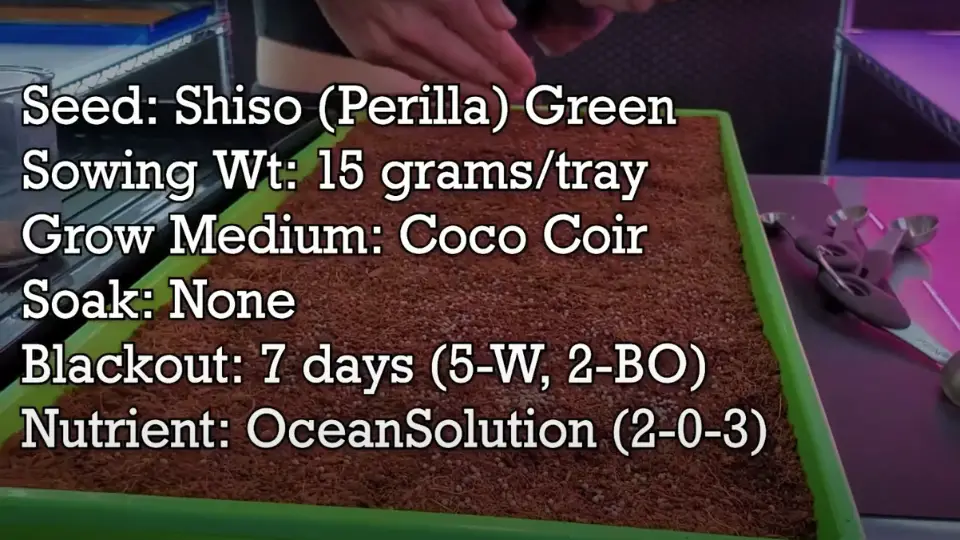
Once your growing medium is ready, spread it evenly in a seed tray or shallow container. Aim for a half-inch depth. Press the soil to compact it slightly, ensuring no large clumps or air pockets.
Great! Now, you’re ready to move on to the next steps in growing your shiso microgreens. In the upcoming sections, we’ll cover planting the seeds, providing optimal care, and harvesting your flavorful shiso microgreens.
Germination And Seeding
To grow shiso microgreens successfully, it is important to understand the process of germination and seeding. This critical stage sets the foundation for healthy and vibrant microgreens. This section will discuss the steps involved in germinating and seeding shiso microgreens.
Soaking And Preparing The Seeds
Before planting the seeds, it is essential to soak and prepare them properly. This helps to enhance germination rates and ensures a higher success rate for your shiso microgreens.
Follow these simple steps to soak and prepare your shiso seeds:
- Use a clean container and fill it with water at room temperature.
- Place the shiso seeds into the container and let them soak for approximately 4-6 hours.
- After soaking, drain the water from the container using a fine-mesh strainer.
- Spread the soaked shiso seeds on a moist paper towel or a seed tray with a thin layer of moistened soil.
- Cover the seeds with another moist paper towel or a thin layer of the same soil mix.
This soaking process helps to soften the shiso seeds’ outer shell, facilitating faster and more successful germination. Once the seeds have been prepared, it’s time to plant.
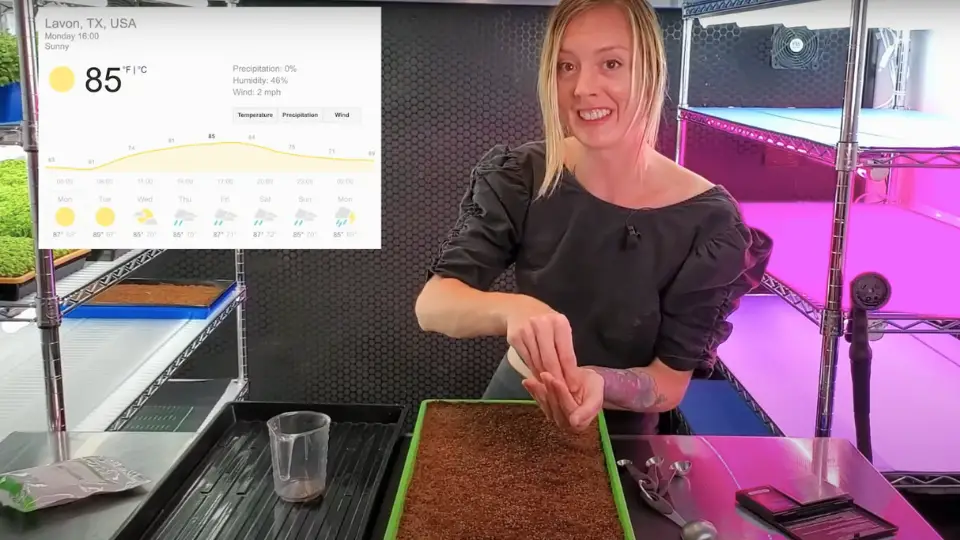
Planting The Shiso Seeds
Now that your shiso seeds are properly soaked and prepared, it’s time to plant them.
Follow these steps to ensure proper planting:
- Prepare a seed tray or a container with a well-draining soil mix.
- Make small indentations in the soil, approximately ¼ inch deep.
- Place a soaked shiso seed in each indentation.
- Gently cover the seeds with soil, ensuring they are adequately covered but not buried too deeply.
- Lightly press down the soil to ensure good seed-to-soil contact.
Remember to label your tray or container to keep track of your shiso microgreens as they grow. With the seeds planted, it’s time to focus on providing optimal germination conditions.
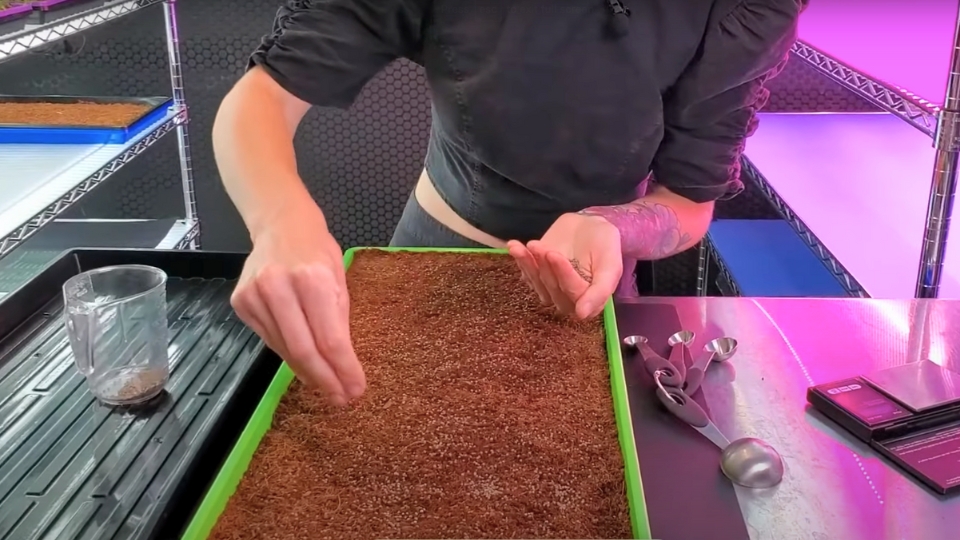
Providing Optimal Germination Conditions
To maximize germination and ensure healthy growth, providing optimal conditions for your shiso microgreens is crucial. Consider the following factors:
- Temperature: Keep your shiso microgreens in a warm environment, ideally between 70-75°F (21-24°C), as this accelerates germination.
- Light: Shiso seeds do not require light during germination, but once sprouted, they benefit from 10-12 hours of bright, indirect light per day.
- Moisture: Throughout germination, ensure the soil remains moist but not waterlogged. Mist the seeds and seedlings gently with water to maintain moisture levels.
These optimal conditions will create a conducive environment for the shiso seeds to sprout and develop into healthy microgreens. Keep a close eye on the germination progress, and in no time, you will see the first signs of growth!
Care And Maintenance
Proper care and maintenance are essential for growing healthy and vibrant shiso microgreens. By following these guidelines, you can ensure that your plants thrive and provide you with a bountiful harvest.
This section will cover important aspects such as watering and humidity levels, temperature and light requirements, and fertilizing the shiso microgreens.
Watering And Humidity Levels
Watering and maintaining appropriate humidity levels are crucial for the growth and development of shiso microgreens. These delicate greens require consistent moisture without being oversaturated.
Here are some tips to help you achieve the right balance:
- Water gently: When watering your shiso microgreens, use a fine mist or can with a narrow spout to avoid damaging the delicate leaves.
- Avoid waterlogging: Ensure that the potting medium drains properly and doesn’t hold excess water, which can lead to root rot.
- Monitor humidity: Shiso microgreens prefer a moderate humidity between 40-60%. You can achieve this by using a small humidifier or placing a water tray near the plants to increase moisture in the surrounding air.
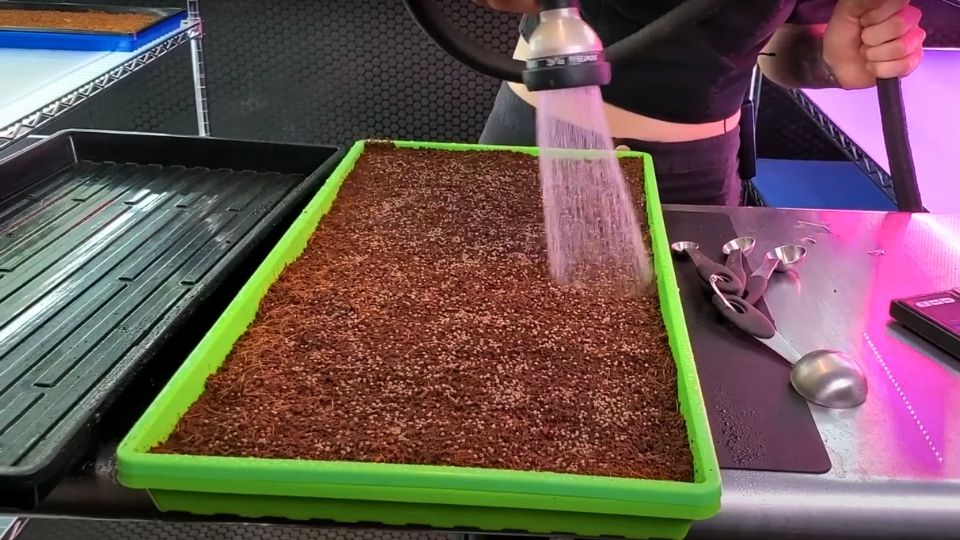
Temperature And Light Requirements
Temperature and light are vital in shiso microgreens’ growth and overall health. Providing the right conditions will promote optimal germination and development of the leaves:
- Temperature range: Shiso microgreens prefer temperatures between 60-75°F (15-24°C) for optimal growth. Avoid exposing them to extreme heat or cold.
- Light intensity: These greens require bright, indirect light for 12-16 hours a day. Place them near a south-facing window or use fluorescent grow lights to ensure they receive enough light.
- Rotate for even growth: To prevent uneven growth towards the light source, gently rotate the tray of microgreens daily.
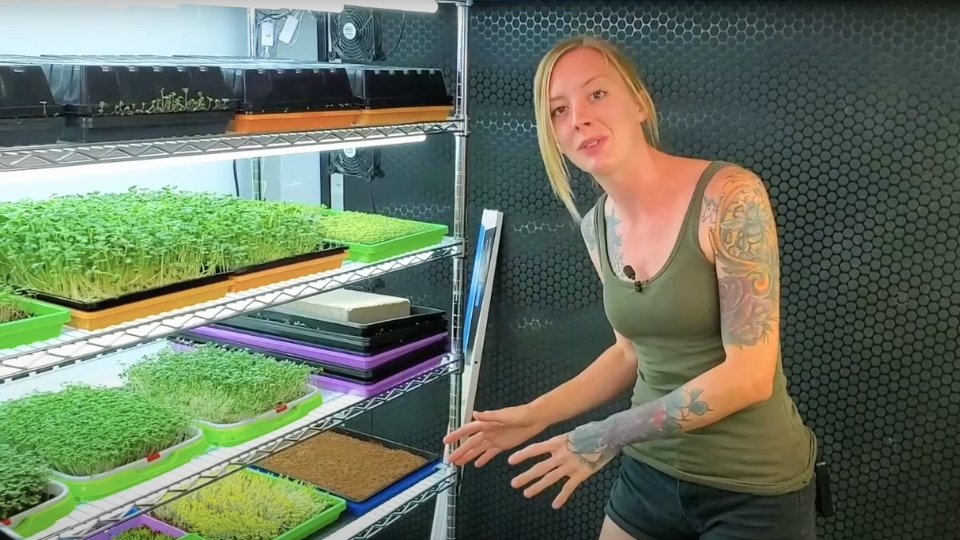
Fertilizing The Shiso Microgreens
Fertilizing shiso microgreens can enhance their nutrient content and promote healthy growth. Here are a few considerations to keep in mind:
- Choose organic fertilizers: Opt for organic options such as compost tea or seaweed extract to avoid chemical residues.
- Start fertilizing after a week: Wait until the shiso microgreens have developed their first set of true leaves before applying a diluted fertilizer solution.
- Use gentle fertilizers: Avoid over-fertilizing, as excess nutrients can lead to stunted growth. Follow the instructions on the fertilizer package, and apply it sparingly.
Pest And Disease Management
Growing shiso microgreens can be a rewarding experience, but it’s important to know potential pests and diseases that can affect your crop.
This section will discuss common pests, natural and organic pest control methods, and how to identify and treat diseases in shiso microgreens.
Common Pests Affecting Shiso Microgreens
Shiso microgreens are vulnerable to a few common pests that can hinder their growth and development. It’s crucial to recognize these pests early on to prevent significant damage to your crop.
Here are some of the most common pests that may affect your shiso microgreens:
- Aphids: These small insects feed on the sap of the plants, causing wilting and stunted growth. Look out for clusters of aphids on the undersides of leaves.
- Whiteflies: These tiny insects with white wings can rapidly reproduce and cause yellowing of leaves, wilting, and sticky residue. They often gather on the undersides of leaves.
- Spider mites: These minuscule pests reside on the undersides of leaves and create fine webbing. They can cause yellowing and spotted leaves, ultimately leading to stunted growth.
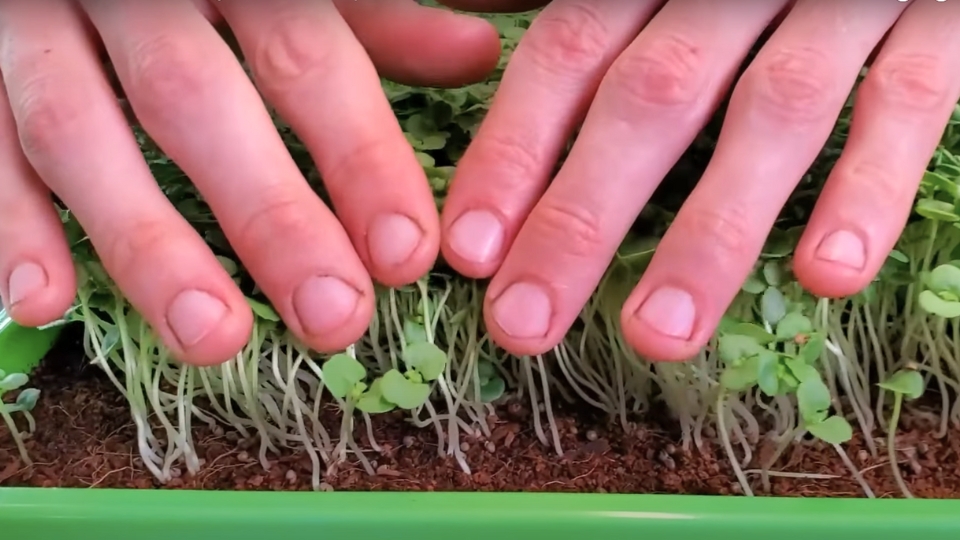
Natural And Organic Pest Control Methods
Regarding pest control in shiso microgreens, a natural and organic approach is crucial to maintaining harvest quality and safety.
Here are some effective methods for controlling pests without the use of harmful chemicals:
- Handpicking: Carefully inspect your shiso microgreens and manually remove any visible pests. This method is time-consuming but can be effective in preventing an infestation.
- Neem oil: Neem oil is a natural insecticide that disrupts the pest’s hormonal balance, preventing them from feeding and reproducing. Dilute neem oil according to the instructions and spray it on your microgreens, targeting the undersides of the leaves.
- Insecticidal soap: This natural soap is specially formulated to control insects. Spray a diluted solution onto your shiso microgreens, ensuring good upper and lower leaf surface coverage.
- Beneficial insects: Introducing natural predators like ladybugs and lacewings to your growing area can help control aphids and other small pests. These beneficial insects feed on harmful pests and provide an eco-friendly solution to pest control.
Identifying And Treating Diseases
Diseases can also affect your Shiso microgreens, causing wilting, discoloration, and even death of the plants. Identifying and treating any disease promptly is important to prevent further spread.
Here are some common diseases that may affect your shiso microgreens:
| Disease | Symptoms | Treatment |
|---|---|---|
| Damping off | Seedlings collapse at the soil level | Improve air circulation, avoid overwatering |
| Powdery mildew | The white powdery coating on the leaves | Remove affected leaves, improve air circulation |
| Root rot | Yellowing, wilting, and decayed roots | Improve drainage, avoid overwatering |
By promptly identifying the disease, you can take appropriate action to treat it and prevent its spread to the rest of your shiso microgreens crop.
Harvesting And Storage
After patiently waiting for your Shiso microgreens to grow, it’s finally time to harvest and enjoy the fruits of your labor! Proper harvesting techniques ensure the best taste and quality. This section will cover everything you need to know about harvesting and storing Shiso microgreens.
Knowing When To Harvest Shiso Microgreens
Knowing when to harvest Shiso microgreens is crucial for maximum flavor and nutrients. The ideal time to harvest is when the plants have reached a height of around 2-3 inches and have developed their first set of true leaves. These leaves are distinguishable from the initial cotyledons by their distinct shape and serrated edges.
Before harvesting, check that the microgreens are vibrant green and not wilting or yellowing. Taste testing one leaf can also give you an idea of flavor intensity. If the taste is too mild, let them grow for another day or two.
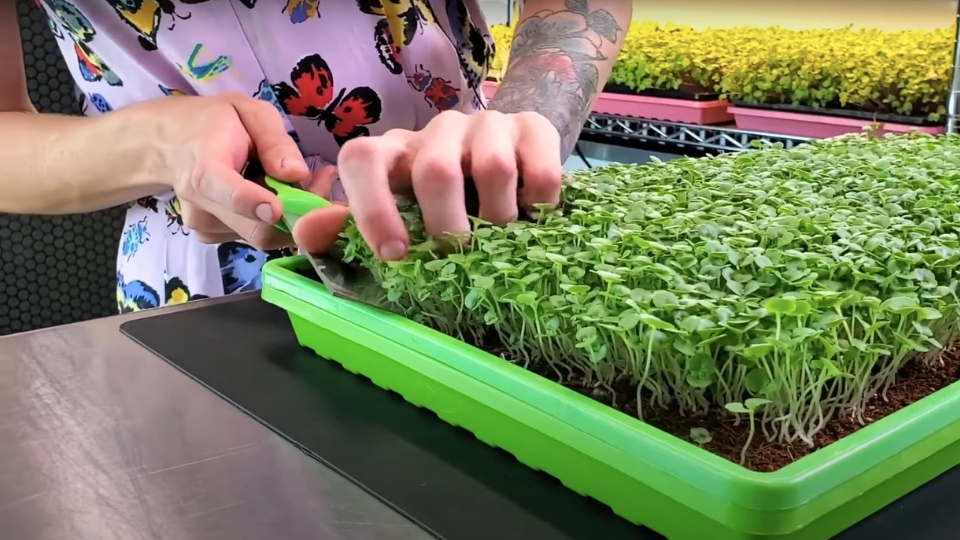
Proper Harvesting Techniques
When it comes to harvesting shiso microgreens, it’s essential to use proper techniques to avoid damaging the plants. Follow these steps:
- Carefully hold the base of the microgreen near the soil line between your fingers.
- Make a clean cut just above the soil surface using a pair of clean scissors or a sharp knife.
- Avoid uprooting the entire plant, as this may damage neighboring microgreens.
Harvesting only the amount you need is crucial, leaving the rest of the microgreens to continue growing. By doing so, you can enjoy multiple harvests from a single tray, extending the lifespan of your shiso microgreens.
Storing And Preserving Shiso Microgreens
Properly storing and preserving shiso microgreens can help prolong their freshness and maintain their vibrant flavor. Follow these guidelines:
- Place harvested shiso microgreens on a paper towel to absorb any excess moisture.
- Gently pat them dry without crushing the delicate leaves.
- Transfer the dry microgreens to an airtight container or a storage bag.
- Place the container in the refrigerator, where the microgreens can stay fresh for up to a week.
Remember to wash the microgreens before consuming them to remove any lingering dirt or microbes. This will also revive their crisp texture.
Now that you know how to properly harvest and store your shiso microgreens, you can indulge in their delightful taste as a topping for salads and soups. You can also use them as a garnish for sushi rolls. Enjoy the freshness and distinct flavor of these nutritious microgreens!
Culinary Uses Of Shiso Microgreens
Regarding culinary uses for Shiso microgreens, the possibilities are endless. These tiny greens pack a big flavor punch and enhance various dishes.
Whether incorporating them into salads and wraps, using them in sushi and Japanese cuisine, or creating shiso-infused oil and vinegar, shiso microgreens add a fresh, herbaceous taste to any meal.
Incorporating Shiso Microgreens In Salads And Wraps
If you’re looking for a simple and nutritious way to add flavor to your salads and wraps, shiso microgreens are the perfect addition. Their delicate leaves and vibrant color make them an eye-catching and flavorful topping.
You can sprinkle them over your greens for freshness or roll them up in a wrap for a satisfying crunch. Combine them with other vegetables, protein, and your favorite dressing to create a healthy and delicious meal.

Shiso Microgreens In Sushi And Japanese Cuisine
Shiso microgreens are commonly used in Japanese cuisine, particularly in sushi—their peppery and slightly minty flavor pairs perfectly with raw fish and rice flavors. You can use them as a garnish for sushi rolls or dice them finely and mix them into your sushi rice for an added layer of flavor.
Additionally, shiso microgreens can be used in traditional Japanese dishes such as tempura or miso soup, providing a fresh and unique taste.
Shiso Infused Vinegar And Oil
If you want to elevate your marinades and dressings, Shiso microgreens are an excellent solution. Infusing vinegar or oil with these microgreens can create a flavorful base for various dishes. Combine the microgreens with vinegar or oil and steep them for a few days.
The result is a tangy and herbaceous dressing or marinade that adds depth and complexity to your meals. Use it to dress salads, drizzle over vegetables, or marinate meats for an unforgettable flavor experience.
Troubleshooting
Discover effective troubleshooting techniques for growing Shiso microgreens. From identifying common problems to finding practical solutions, this guide will help you achieve successful cultivation and optimal growth for your Shiso plants.
When growing Shiso microgreens, preparing for potential issues is important. Troubleshooting common problems promptly can help ensure the success of your crop. This section will look at some common issues you may encounter and suggest solutions. Let’s dive in!
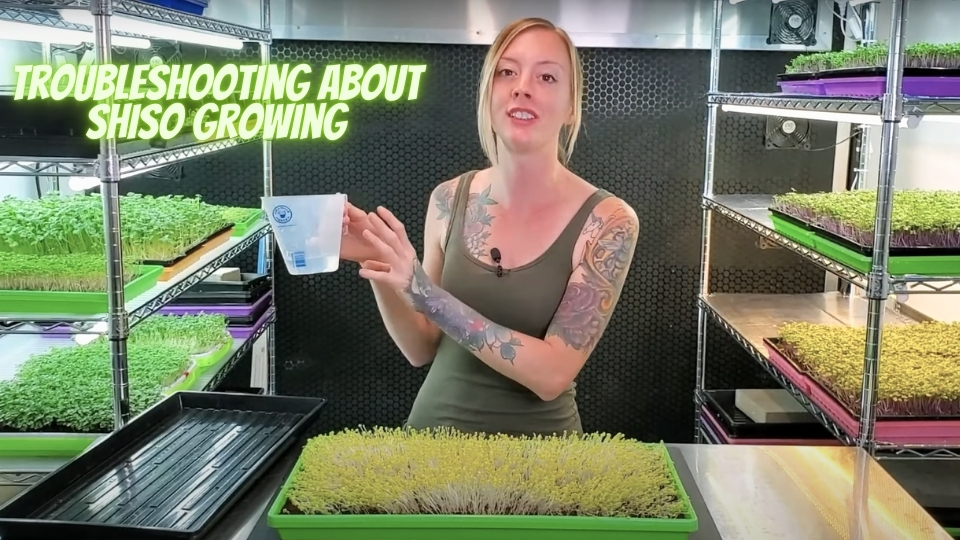
Common Issues And Solutions
To help you overcome any challenges you may face while growing shiso microgreens, we have compiled a list of common issues and their solutions. Look at the table below to find your problem and its corresponding solution.
| Issue | Solution |
|---|---|
| Slow or uneven germination | Ensure proper moisture levels and temperature, use fresh and viable seeds |
| Leggy growth | Provide sufficient light, and adjust the height of grow lights if necessary. |
| Pale leaves | Expose the microgreens to more sunlight or increase the intensity of artificial lights. |
| Yellowing or wilting | Refer to section 8.2 for detailed solutions |
| Mold or fungus | Refer to section 8.3 for detailed solutions |
Dealing With Yellowing Or Wilting
Yellowing or wilting of shiso microgreens can be a sign of nutrient deficiencies, overwatering, or poor drainage. Here are a few steps you can take to address this issue:
- Double-check the watering schedule. Overwatering can lead to root rot and yellowing. Ensure the growing medium is damp but not waterlogged.
- Make sure the microgreens are receiving adequate sunlight or artificial light. Lack of light can cause yellowing and weak growth.
- Check the nutrient levels in your growing medium. Consider using a balanced fertilizer formulated explicitly for microgreens.
- Improve drainage by using well-draining soil or adding perlite to your growing medium.
Preventing Mold And Fungus
Mold and fungus can be common when growing shiso microgreens, especially in humid environments. To prevent mold and fungus from taking over your crop, follow these preventive measures:
- Ensure proper air circulation in your growing area. Use a small fan to keep the air moving and prevent stagnant conditions.
- Avoid overwatering. Allow the top layer of soil to dry out slightly between waterings.
- Keep the growing area clean and free from debris. Regularly remove any fallen leaves or organic matter.
- If mold or fungus does appear, gently remove and discard the affected microgreens to prevent further spread.
Frequently Asked Questions On How To Grow Shiso Microgreens
How Do You Grow Micro Shiso?
To grow micro shiso, select a sunny spot and prepare well-drained soil. Sow the seeds thinly and cover them lightly with soil. Keep the soil consistently moist and water regularly. Harvest the leaves when they reach the desired size, usually after 3-4 weeks.
How Do You Grow Perilla Microgreens?
To grow Perilla microgreens, follow these steps: Prepare a tray and fill it with soil. Sprinkle the Perilla seeds evenly on top. Water the seeds daily, but don’t oversaturate. Place the tray in a well-lit area, but avoid direct sunlight.
After 1-2 weeks, harvest the microgreens by snipping them above the soil.
Is Shiso Easy To Grow?
Yes, shiso is easy to grow. It requires minimal care and thrives in various climates. It can be grown in pots or in the garden. Regular watering and sunlight are essential for its growth. Harvest the leaves when they are young for the best flavor.
Our Final Word
Growing Shiso microgreens is rewarding and enjoyable. Following the tips and techniques outlined in this blog post, you can cultivate these versatile microgreens in your home. Remember to provide the right conditions, such as proper lighting, watering, and thinning, to ensure the best results.
With a bit of patience and care, you can enjoy the fresh and vibrant flavors of Shiso microgreens in your dishes. Happy growing!
Video Source: https://www.youtube.com/watch?v=UbVJtPXIK1s

